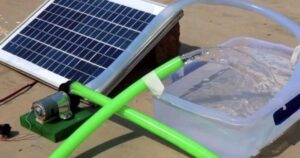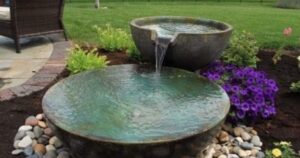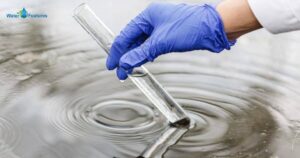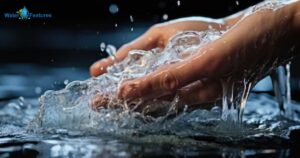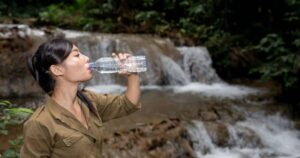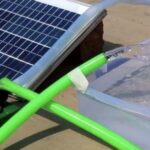When we mention hose water, we refer to water flowing through a garden hose or hose bib, typically used for outdoor activities such as gardening, cleaning, or pool filling. On the other hand, tap water is the water that comes directly from your home’s plumbing system, often intended for various indoor uses, including drinking, cooking, and bathing. The stark contrast lies in their source, treatment, and regulations, which sets them apart in terms of safety and taste.
Is Hose Water The Same As Tap Water? It’s not a trivial question, considering the potential health and taste disparities. A scorching summer day, and you’re quenching your thirst with a sip from the garden hose. But have you ever noticed that the water doesn’t quite taste like the refreshing tap water you’re used to? Let’s uncover the mysteries behind this difference.
One of the fundamental distinctions between hose water and tap water is that hose water is not typically safe for direct consumption due to the absence of rigorous treatment processes. While tap water is regulated to meet stringent quality standards in most developed countries, hose water is primarily intended for external use and may contain impurities or contaminants that make it unsuitable for drinking.
Hose Water vs Tap Water
When it comes to water, it’s essential to consider its source and quality. Many people wonder if hose water is the same as tap water, and whether it’s safe for various purposes. In this article, we will explore the key differences between hose water and tap water, their safety, and why they may taste different. We’ll also delve into the sources of hose water and potential contaminants. So, let’s get to the bottom of this watery conundrum and discuss how to use water-activated tape effectively.
Hose Water vs Tap Water
Before we delve into the specifics, let’s establish the fundamental distinctions between hose water and tap water
Hose Water:
Source: Typically comes from an outdoor garden hose or hose bib.
Use: Primarily intended for outdoor activities like watering plants, cleaning, or filling pools.
Temperature: Often affected by outdoor temperatures, which can lead to variations in water temperature.
Treatment: Usually not subject to the same level of treatment as tap water, potentially containing more impurities.
Tap Water:
Source: Supplied by a municipal water system or well, depending on your location.
Use : Meant for drinking, cooking, bathing, and various household purposes.
Temperature: Generally regulated to maintain a consistent temperature.
Treatment: Subject to rigorous treatment processes to meet drinking water standards.
Now that we’ve established the primary distinctions, let’s address some common questions regarding tap and hose water.
Can I Drink Tap Water Directly?
You can drink tap water directly in most developed countries, as it is subject to stringent quality regulations and treatment processes. The safety of tap water can vary depending on your location. In some areas, additional filtration or purification may be necessary to address local water quality concerns.
Is Hose Water Safe to Drink?
Hose water is not typically safe for drinking without appropriate filtration or treatment. It is generally considered non-potable due to the absence of the same rigorous treatment processes that tap water undergoes. Hose water may contain impurities, chemicals, or contaminants that can be harmful when ingested.
Is Hose Water Safe to Shower?
Showering with hose water is generally safe for the skin and external use. However, avoid ingesting water or getting it into your eyes, nose, or mouth during the shower, as it may contain impurities that can be harmful when exposed to mucous membranes.
Why Does Tap Water Taste Different From Water From A Garden Hose?
The difference in taste between tap water and hose water can be attributed to various factors, including the following:
Contaminants in Garden Hose Water
Hose water may contain contaminants such as
Chemicals: Some hoses are made of materials that can leach chemicals into the water, affecting its taste and safety.
Microorganisms: Stagnant water in hoses can promote the growth of microorganisms, leading to an unpleasant taste.
Metals: Hoses may contain metal components that can leach into the water, altering its flavor.
Where Does Your Hose Water Come From?
The source of your hose water can also impact its taste and quality. Let’s explore the possible origins of hose water.
City Water
If your garden hose is connected to the municipal water supply, the taste of your hose water is likely to resemble tap water. However, it may still pick up some contaminants from the hose itself.
Well Water
Hose water from a well can have a distinct taste due to the natural minerals and geological characteristics of the well’s water source. It might taste different from tap water supplied by a municipality.
Rain Catchment Tank or Water Butt
Water collected in rain catchment tanks or water butts is typically used for outdoor purposes. This water can taste different from tap water, especially if it contains debris or pollutants collected during the rain.
Why Does Water from a Garden Hose Taste Different from Tap Water?
The taste difference between hose water and tap water can be attributed to the following factors.
Exposure to Materials: Hoses may contain materials like PVC, rubber, or metal, which can impart their flavors to the water.
Temperature Fluctuations: Hose water can experience extreme temperature changes, affecting its taste, especially if it becomes excessively hot or cold.
Contaminants: Hose water is more prone to picking up contaminants, such as algae, bacteria, or chemicals, from the hose itself or the surrounding environment.
Where Does Hose Water Come From?

The source of your hose water can vary depending on your location, and it’s important to understand where it comes from to assess its quality. In most homes, hose water can be traced back to one of the following sources
City Water
Hose water in many urban areas is supplied by the municipal water system. In such cases, the hose is usually connected to the same water source that provides tap water to your home. However, it’s important to note that the hose itself can introduce contaminants.
Well Water
In homes with private wells, hose water often originates from the same well that supplies water for household use. The taste of hose water from a well can be distinct, and influenced by the well’s water quality and mineral content.
Rain Catchment Tank or Water Butt
In some cases, homeowners collect rainwater in tanks or water butts for outdoor use. This water is generally untreated and can vary in quality depending on environmental factors, such as the cleanliness of the catchment system and the local air quality.
What Is Meant by Most Homes?
When we refer to most homes, we are generally speaking about residential properties in developed countries with access to municipal water systems. These systems typically provide treated and regulated tap water to households. The water quality and safety standards in such locations are relatively high, making tap water a suitable choice for drinking and various domestic uses.
It’s important to note that water sources and quality standards can vary significantly around the world. In some areas, tap water may not meet the same high standards, making it necessary to take additional precautions.
Outside Water is Unmonitored for Cleanliness
Unlike tap water, which is subject to rigorous testing and monitoring, water from hoses is often overlooked in terms of cleanliness. Hoses can accumulate dirt, debris, and microorganisms over time, especially if they are not properly maintained or if stagnant water remains inside the hose. This lack of monitoring and maintenance can lead to potential health risks when using hose water for drinking or other domestic purposes.
Unclean Water Can Cause Health Effects
Using unclean hose water, especially for drinking, can lead to a range of health issues. Some potential consequences of using contaminated hose water include.
Gastrointestinal Issues: Ingesting waterborne pathogens or contaminants can lead to stomach problems, diarrhea, and other gastrointestinal disorders.
Skin Irritation: Bathing or showering with water containing impurities can result in skin irritation and dryness.
Respiratory Problems: Inhaling aerosolized contaminants in the shower can potentially lead to respiratory issues, especially for individuals with preexisting conditions.
FAQ’s
Can I drink hose water directly?
No, drinking hose water directly is not recommended. Hose water is typically not treated to the same standards as tap water and can contain contaminants.
Is hose water safe for gardening and outdoor use?
Yes, hose water is generally safe for gardening and outdoor use. It’s be cautious when using it for plants that are sensitive to certain contaminants or chemicals present in the hose water.
How can I make hose water safe for drinking?
To make hose water safe for drinking, you should use a water filter or purifier specifically designed for such purposes.
Are there any health risks associated with using unfiltered hose water?
Yes, using unfiltered hose water can pose health risks, particularly if ingested or used for activities like showering.
Conclusion
hose water and tap water are not the same, with notable differences in source, use, treatment, and safety. While tap water is generally safe for drinking and household use in most developed countries, hose water is intended primarily for outdoor activities and may contain contaminants that make it unsuitable for direct consumption.
Understanding the source of your hose water and the potential for contamination is essential for making informed decisions about its use. When in doubt, it’s advisable to use appropriate filtration or purification methods to ensure the safety of hose water for drinking or other domestic purposes. Always prioritize your health and safety when it comes to water consumption and use.


